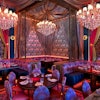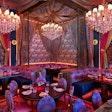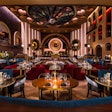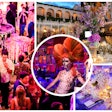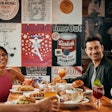
The busy crowds in the large tasting tent.
Two seasons ago I filed from down here with good news—South Beach was alive and well, despite naysayers and movers on.
Then, a rash of new hotels, namely the Raleigh, the Shore Club, and the Ritz-Carlton, had all landed with cash and energy, revitalizing a scene that had grown tired (not to mention sad, thanks to the gunning down of Gianni Versace). The Setai was still a construction site, but the quiet visual sophistication of its beachfront models told us not to worry.
Well, I’m finally back, but it seems that something left while I was gone. Here’s what is going on:
All the Gays Guys Have Gone to Fort Lauderdale
Specifically, they’re buying two-bedroom condos in Wilton Manors for between $400,000 and $500,000, which are going for half that price still on Collins and Washington in South Beach. Paying Aspen and Hamptons prices and decorating like crazy, Florida’s gay contingent is burgeoning, thanks to a few (and some say unscrupulous) savvy gay realtors and promoters. It’s a weird scene they’ve created, kind of sexy and sleazy, but I have a bad feeling about it. All the ads and flyers hark back to a wild and crazy time, and Broward County now has one of the highest AIDS infection rates in the country.
…So the Cute and Swishy Hotels Have Evaporated
While Paris Hilton and Jessica Simpson party at Nikki Beach at the Setai, nifty little hotels like Mermaid and the Century are sold. South Beach is now a town of the haves and have-nots. Unable to compete with the big guys, places that helped put this town back on the map—like the Colony and the Cardoza (remember Todd Oldham? Gloria Estefan? When was the last time they were in South Beach?)—seem shabby and out of date now.
The Big Restaurants Are Booming…
“Ain’t No Stoppin’ Us Now” could be the theme song of China Grill, mobbed on a recent visit, where the food was fine but the harried service was not. Prime 112 is the corporate steak joint and Emeril Lagasse has a restaurant at the eyesore Loews complex, both busy (and not bad).
…But the Cuban, International, Multiculti Vibe Has Faded
Forget Ocean Drive—we all did years ago. Now it is the kind of place that has plastic replicas of the food they serve out front like in bad Chinatown. But even the commercial creativity that brought us the first meals you could eat while lying down (BED) and hyped up aphrodisiac benefits of raw food (sushi at Flirt) could not be deader than a doornail.
But this place still has legs. You just need leg to appreciate it. I went to the recent South Beach Wine and Food Festival (benefiting Florida International University) to see what (if any) worthwhile ideas were being presented at this extravaganza.
I saw plenty, both good and bad. (Disclosure: I was involved peripherally at the launch of this festival, as well as with its presenting sponsor, Food & Wine magazine.)
Just a few years old, the festival has grown into one of those behemoth events you can feel from miles around. On a beach walk surveying the surprisingly still raw damage from Hurricane Wilma (that’s the one that came after Katrina—poor little sister got no press but did an impressive job), the massive and many tents loomed large. Despite my planned attendance a few days later, it never dawned on me that this whole operation could be the food festival I had previously attended. I thought it was a Who concert. But on the opening day, chaos was replaced by calm. (The inaugural opening morning was marred by security tussling foodie and In Style guru Hal Rubenstein, resulting in a whole police-involved debacle.) Well, not calm so much as competence, because the disorganized security has been replaced by efficient greeters.
Now there are Q&A people everywhere, signs on backstage tent exits with numbers so vendors can find their display space—basic planning stuff really, but lots of it. My favorite touch? FedEx has a display/shipping center, so participants and guest alike can get their goodie bag hauls signed, sealed, and delivered. I stopped by and picked up some blank forms, disappointed I didn’t have enough to ship.
Credit, I’m told, belongs to Devin Padgett, who has worked on the event for two years now. Padgett has been producing the Food & Wine Classic in Aspen, the gold standard for events like these, for as long as I have known him, which is more than a decade. I think. Anyway, the magazine executives saw that this event needed some TLC and so reluctantly gave Southern Wine & Spirits, which runs the show, Padgett’s Colorado number.
But organization can’t provide soul, and the problem with bigger is the lack of better. So many of the wine and spirits exhibitors were grocery store brands, or worse, the kind of liquors you see advertised in beverage barns with giant display and scantily clad models offering you a taste of “pure passion.”
But guests seemed to be literally eating it up, including even a cheese station where they offered fresh cheese curds (that’s what cheese is after it’s milk and before it is cheese, but definitely does not look edible). But serious wine people—no, take that back, I am not a serious wine person, only slightly informed—will find this to be a real letdown. I’m not saying there’s anything wrong with a festival to tell people what kind of wine to buy at the supermarket. There’s a need. Some notes:
Champagne for Everybody
I have no idea if it is working, but I’ve noticed that many French champers purveyors have adopted a new aggressive and decidedly raunchy edge to their promotions. A preparty hosted by Veuve Clicqout featured Dita Von Teese knock-offs (that’s near-naked girls in giant glasses of sparkling liquid for the uninitiated) and at the festival’s opening party, the Bubble Q (that’s barbecue provided by Bobby Flay, et al, and champagne, get it?) Moët & Chandon had Vegas-style showgirls with cellophane headdresses, tons of makeup, and old-fashioned nude hose. Inside the tents the next day, the dark side continued prevailing, with the champagne booths (if you can call a thirty-foot-high tent of Lycra and orange plastic a booth) pounding out the bubbles and mayhem all day, taking away from the atmosphere of inquisitiveness and information that better wine pouring events provide.
If all this is ringing the cash registers, fine, but all this free bubbly given in tents to twentysomethings with no lecture, no brochures, nothing about the methode champenoise, makes me wonder whether the companies are promoting or devaluing a centuries-old process that requires tremendous labor and precision.
Reidel
A classy touch is being handed a Reidel wine glass as you enter the tent. So what if it is huge and hard to carry, and the non-leaded (read cheaper) line that is sold at Target (which also had its own pavilion). It is still a fine piece of glass that enhanced the sipping and spitting (well, OK, I don’t spit), so I stopped by that area. Uniformly well-informed staff told me everything I needed to know, or so I thought, until I read the glossy black brochure that describe like 100 different kinds of wines and the glass that suits them. I learned more from that book in 20 minutes than at any event or seminar I’ve attended (yeah, yeah, Robert Parker, Napa Culinary Institute, been there).
Charles Krug
Every cloud has it’s day, or something, and mine was finding Charles Krug pouring Sauvignon Blanc after a disappointing stop at the Tio Pepe booth, where I learned that a bottle lasts three months max after being opened, meaning the half-filled bottle in my house that my grandmother left behind is now good only for cooking. The gentleman told me about citrus and pineapple aromas and sometimes when I hear talk like that I think the whole wine world is just so full of it. But lo and behold, even this philistine smelled a bit of pineapple. Next up Generations, a premium blend on the market a few years that is 60 percent Cabarnet, 1 percent Syrah, and a bunch of others in between including Merlot and Petite Verdeau (my notes and math get fuzzy here; it was the best wine in the tent). It is the oldest Napa vineyard, founded in 1861 and owned by the Mondavi family, which I no longer hold against them. I’ll buy wine from Jerry Falwell if it is this elegant.
Celebrity Chefs
I remember once opining that celebrity chefs would replace fashion designers as the next celebrities and the world would be a better place because these educated, well-centered (food people are well centered, right?) folks would help us diverge from the path of uniformity and glibness that Tom Cruise so despairs. But along comes Rachael Ray to spoil the show. Within three minutes of entering her tent in mid-presentation I heard her compare herself to Bobby Flay and Mario Batali, talk about her relationship with Emeril Lagasse, and plug her own show. I can’t imagine what the full hour might have entailed, three minutes was enough. Rachael Ray is the Ashlee Simpson of the food world, propped up by promotion and celebrity affiliation. Her cooking and recipes are uninspired, her self-deprecation wildly transparent, and her talent still in question. Somebody, please, start the booing.
Emeril, on the other hand, I just love, even though all chefs love to hate him. He rode past me in a golf cart, the Sultan of Salami, looking pale and unwell (as he always does in person), and waved to me. It is the foodie version of being blessed by the pope. Amen.
On Another Planet
Five blocks from the heart of South Beach, which keeps inching up and now ends around 20th Street, there is an amazing public botanical garden that had only one other visitor beside myself on a recent holiday weekend. Stopping for a coffee at an interesting looking old building, the Indian Creek Hotel, I stumbled upon Creek 28. I claim to be an expert on many things, and one of them is monkfish. I can cook it, sauté it, bake it, wrap it, you name it. I eat it everywhere. But the monkfish stew here was sublime. Seems executive chef Kira Volz was the hash slinger at the Abbey, the much-missed restaurant closed to make room for the Setai.
Volz was recruited to be the centerpiece of this hotel renovation, and things are off to a good start. The restaurant is the hotel, with tables everywhere—the lobby, the dining room, the patio, even a hallway when I first visited, such is her following. The building dates to 1936, has original cypress ceilings, and overlooks the nifty Indian Creek.
I asked Volz why she wasn’t participating in the Wine & Food Festival as she had in years past. “Well, it has nothing to do with the food scene down here. It’s celebrity chefs plugging name brand establishments. We learned that the festival visitor is not our customer.”
Volz poaches figs in white wine for a goat cheese tart, puts Tabasco in the chicken pot pie, and has a staff of people of every shape and size and color who followed her from the Abbey. Already given a near rave by The Miami Herald (it isn’t in my notes when the restaurant opened, but she kept referring to three weeks ago and six weeks ago in telling me the history of the place, so I guess it’s new), they are doing well.
The hotel renovation is taking place next and it will be interesting to see if this sleepy and non-service-oriented hotel in an architectural oddity can keep up with the team at its lobby restaurant.
We’ll see.
Columnist Ted Kruckel is an experienced and opinionated former event and PR pro who ran events for 20 years for high-profile clients like Vanity Fair, Elle Decor, Christian Dior, and Carolina Herrera. He shuttered his firm, Ted Inc., in 2003. You can email him at [email protected].
Posted 03.01.06
Photos: Michael Katz (festival)
Then, a rash of new hotels, namely the Raleigh, the Shore Club, and the Ritz-Carlton, had all landed with cash and energy, revitalizing a scene that had grown tired (not to mention sad, thanks to the gunning down of Gianni Versace). The Setai was still a construction site, but the quiet visual sophistication of its beachfront models told us not to worry.
Well, I’m finally back, but it seems that something left while I was gone. Here’s what is going on:
All the Gays Guys Have Gone to Fort Lauderdale
Specifically, they’re buying two-bedroom condos in Wilton Manors for between $400,000 and $500,000, which are going for half that price still on Collins and Washington in South Beach. Paying Aspen and Hamptons prices and decorating like crazy, Florida’s gay contingent is burgeoning, thanks to a few (and some say unscrupulous) savvy gay realtors and promoters. It’s a weird scene they’ve created, kind of sexy and sleazy, but I have a bad feeling about it. All the ads and flyers hark back to a wild and crazy time, and Broward County now has one of the highest AIDS infection rates in the country.
…So the Cute and Swishy Hotels Have Evaporated
While Paris Hilton and Jessica Simpson party at Nikki Beach at the Setai, nifty little hotels like Mermaid and the Century are sold. South Beach is now a town of the haves and have-nots. Unable to compete with the big guys, places that helped put this town back on the map—like the Colony and the Cardoza (remember Todd Oldham? Gloria Estefan? When was the last time they were in South Beach?)—seem shabby and out of date now.
The Big Restaurants Are Booming…
“Ain’t No Stoppin’ Us Now” could be the theme song of China Grill, mobbed on a recent visit, where the food was fine but the harried service was not. Prime 112 is the corporate steak joint and Emeril Lagasse has a restaurant at the eyesore Loews complex, both busy (and not bad).
…But the Cuban, International, Multiculti Vibe Has Faded
Forget Ocean Drive—we all did years ago. Now it is the kind of place that has plastic replicas of the food they serve out front like in bad Chinatown. But even the commercial creativity that brought us the first meals you could eat while lying down (BED) and hyped up aphrodisiac benefits of raw food (sushi at Flirt) could not be deader than a doornail.
But this place still has legs. You just need leg to appreciate it. I went to the recent South Beach Wine and Food Festival (benefiting Florida International University) to see what (if any) worthwhile ideas were being presented at this extravaganza.
I saw plenty, both good and bad. (Disclosure: I was involved peripherally at the launch of this festival, as well as with its presenting sponsor, Food & Wine magazine.)
Just a few years old, the festival has grown into one of those behemoth events you can feel from miles around. On a beach walk surveying the surprisingly still raw damage from Hurricane Wilma (that’s the one that came after Katrina—poor little sister got no press but did an impressive job), the massive and many tents loomed large. Despite my planned attendance a few days later, it never dawned on me that this whole operation could be the food festival I had previously attended. I thought it was a Who concert. But on the opening day, chaos was replaced by calm. (The inaugural opening morning was marred by security tussling foodie and In Style guru Hal Rubenstein, resulting in a whole police-involved debacle.) Well, not calm so much as competence, because the disorganized security has been replaced by efficient greeters.
Now there are Q&A people everywhere, signs on backstage tent exits with numbers so vendors can find their display space—basic planning stuff really, but lots of it. My favorite touch? FedEx has a display/shipping center, so participants and guest alike can get their goodie bag hauls signed, sealed, and delivered. I stopped by and picked up some blank forms, disappointed I didn’t have enough to ship.
Credit, I’m told, belongs to Devin Padgett, who has worked on the event for two years now. Padgett has been producing the Food & Wine Classic in Aspen, the gold standard for events like these, for as long as I have known him, which is more than a decade. I think. Anyway, the magazine executives saw that this event needed some TLC and so reluctantly gave Southern Wine & Spirits, which runs the show, Padgett’s Colorado number.
But organization can’t provide soul, and the problem with bigger is the lack of better. So many of the wine and spirits exhibitors were grocery store brands, or worse, the kind of liquors you see advertised in beverage barns with giant display and scantily clad models offering you a taste of “pure passion.”
But guests seemed to be literally eating it up, including even a cheese station where they offered fresh cheese curds (that’s what cheese is after it’s milk and before it is cheese, but definitely does not look edible). But serious wine people—no, take that back, I am not a serious wine person, only slightly informed—will find this to be a real letdown. I’m not saying there’s anything wrong with a festival to tell people what kind of wine to buy at the supermarket. There’s a need. Some notes:
Champagne for Everybody
I have no idea if it is working, but I’ve noticed that many French champers purveyors have adopted a new aggressive and decidedly raunchy edge to their promotions. A preparty hosted by Veuve Clicqout featured Dita Von Teese knock-offs (that’s near-naked girls in giant glasses of sparkling liquid for the uninitiated) and at the festival’s opening party, the Bubble Q (that’s barbecue provided by Bobby Flay, et al, and champagne, get it?) Moët & Chandon had Vegas-style showgirls with cellophane headdresses, tons of makeup, and old-fashioned nude hose. Inside the tents the next day, the dark side continued prevailing, with the champagne booths (if you can call a thirty-foot-high tent of Lycra and orange plastic a booth) pounding out the bubbles and mayhem all day, taking away from the atmosphere of inquisitiveness and information that better wine pouring events provide.
If all this is ringing the cash registers, fine, but all this free bubbly given in tents to twentysomethings with no lecture, no brochures, nothing about the methode champenoise, makes me wonder whether the companies are promoting or devaluing a centuries-old process that requires tremendous labor and precision.
Reidel
A classy touch is being handed a Reidel wine glass as you enter the tent. So what if it is huge and hard to carry, and the non-leaded (read cheaper) line that is sold at Target (which also had its own pavilion). It is still a fine piece of glass that enhanced the sipping and spitting (well, OK, I don’t spit), so I stopped by that area. Uniformly well-informed staff told me everything I needed to know, or so I thought, until I read the glossy black brochure that describe like 100 different kinds of wines and the glass that suits them. I learned more from that book in 20 minutes than at any event or seminar I’ve attended (yeah, yeah, Robert Parker, Napa Culinary Institute, been there).
Charles Krug
Every cloud has it’s day, or something, and mine was finding Charles Krug pouring Sauvignon Blanc after a disappointing stop at the Tio Pepe booth, where I learned that a bottle lasts three months max after being opened, meaning the half-filled bottle in my house that my grandmother left behind is now good only for cooking. The gentleman told me about citrus and pineapple aromas and sometimes when I hear talk like that I think the whole wine world is just so full of it. But lo and behold, even this philistine smelled a bit of pineapple. Next up Generations, a premium blend on the market a few years that is 60 percent Cabarnet, 1 percent Syrah, and a bunch of others in between including Merlot and Petite Verdeau (my notes and math get fuzzy here; it was the best wine in the tent). It is the oldest Napa vineyard, founded in 1861 and owned by the Mondavi family, which I no longer hold against them. I’ll buy wine from Jerry Falwell if it is this elegant.
Celebrity Chefs
I remember once opining that celebrity chefs would replace fashion designers as the next celebrities and the world would be a better place because these educated, well-centered (food people are well centered, right?) folks would help us diverge from the path of uniformity and glibness that Tom Cruise so despairs. But along comes Rachael Ray to spoil the show. Within three minutes of entering her tent in mid-presentation I heard her compare herself to Bobby Flay and Mario Batali, talk about her relationship with Emeril Lagasse, and plug her own show. I can’t imagine what the full hour might have entailed, three minutes was enough. Rachael Ray is the Ashlee Simpson of the food world, propped up by promotion and celebrity affiliation. Her cooking and recipes are uninspired, her self-deprecation wildly transparent, and her talent still in question. Somebody, please, start the booing.
Emeril, on the other hand, I just love, even though all chefs love to hate him. He rode past me in a golf cart, the Sultan of Salami, looking pale and unwell (as he always does in person), and waved to me. It is the foodie version of being blessed by the pope. Amen.
On Another Planet
Five blocks from the heart of South Beach, which keeps inching up and now ends around 20th Street, there is an amazing public botanical garden that had only one other visitor beside myself on a recent holiday weekend. Stopping for a coffee at an interesting looking old building, the Indian Creek Hotel, I stumbled upon Creek 28. I claim to be an expert on many things, and one of them is monkfish. I can cook it, sauté it, bake it, wrap it, you name it. I eat it everywhere. But the monkfish stew here was sublime. Seems executive chef Kira Volz was the hash slinger at the Abbey, the much-missed restaurant closed to make room for the Setai.
Volz was recruited to be the centerpiece of this hotel renovation, and things are off to a good start. The restaurant is the hotel, with tables everywhere—the lobby, the dining room, the patio, even a hallway when I first visited, such is her following. The building dates to 1936, has original cypress ceilings, and overlooks the nifty Indian Creek.
I asked Volz why she wasn’t participating in the Wine & Food Festival as she had in years past. “Well, it has nothing to do with the food scene down here. It’s celebrity chefs plugging name brand establishments. We learned that the festival visitor is not our customer.”
Volz poaches figs in white wine for a goat cheese tart, puts Tabasco in the chicken pot pie, and has a staff of people of every shape and size and color who followed her from the Abbey. Already given a near rave by The Miami Herald (it isn’t in my notes when the restaurant opened, but she kept referring to three weeks ago and six weeks ago in telling me the history of the place, so I guess it’s new), they are doing well.
The hotel renovation is taking place next and it will be interesting to see if this sleepy and non-service-oriented hotel in an architectural oddity can keep up with the team at its lobby restaurant.
We’ll see.
Columnist Ted Kruckel is an experienced and opinionated former event and PR pro who ran events for 20 years for high-profile clients like Vanity Fair, Elle Decor, Christian Dior, and Carolina Herrera. He shuttered his firm, Ted Inc., in 2003. You can email him at [email protected].
Posted 03.01.06
Photos: Michael Katz (festival)

